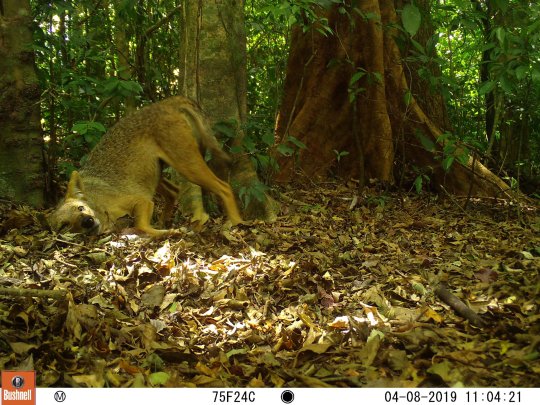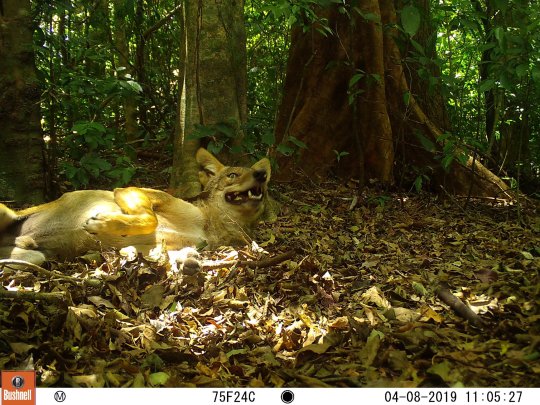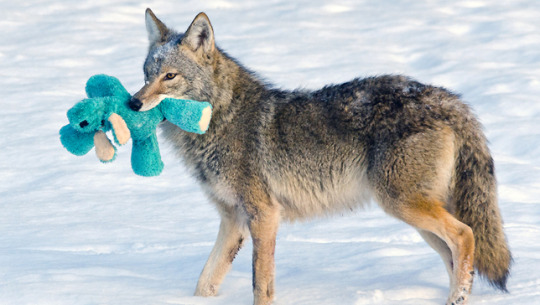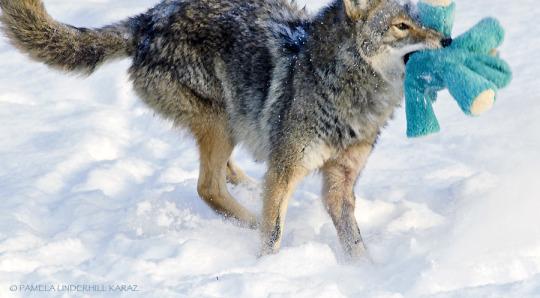Photo



For my thesis research, I placed carpet pieces sprayed liberally with Calvin Klein Obsession for Men near my camera traps as it’s been documented to attract wild cats. It was an extra fun surprise to see who else enjoyed it
28K notes
·
View notes
Text
talk to me about profound, formative events in adulthood impacting people's settled daemons. are their shapes set in stone? would a strong enough experience manage to cause a crack in their settled shape? is there such a thing as daemon dysphoria? do our daemons define us, or do we define them?
82 notes
·
View notes
Text
On Waves of Dæmonism and Dænominations
Every now and again I'll stumble across a conversation about daemonism and I'm left anywhere from bemused to uncomfortable, thinking "that's really not how daemonism works". Yet, I'll dig deeper and see communities of people very happily practising.
So what gives?
I've come to understand there are multiple waves of daemonism. These have developed into "daenominations" that can have mutually exclusive underlying principles. Recently I've mostly seen people advertising and discussing the third wave as though it's an evolution of previous principles, or as an umbrella to previous ideas, which set off my alarm bells.
So I want to talk about these waves and daenominations and roughly what I see defines them, with emphasis on my "own" - the second.
First wave: Canonical - "The books define it"
In the early days, the definition of a daemon was very much like that in the "His Dark Material" books. The books were referenced often and the form your daemon took in projection was often considered significant. So daemon and form, like in the books, were intrinsically linked. There was a strong spiritual element or significance for many, as in the books daemons were thought of as your soul, and to stop projecting completely was considered a significant event. Analyses were more literal in nature rather than interpreted.
Second wave: Prescriptivist - "We define it"
Around 2007-09, as more people joined the community began to move towards a more stripped down understanding of daemonism. This was a push back against the canonical "daemon as a soul" basis of the first wave. Around the same time, the philosophy of New Atheism was born as a reaction to the perceived dominance of the Christian understanding of reality. Given the strength of the parallel, it's likely this wider cultural shift influenced the second wave.
The stripped back view was thus: a daemon was an imaginary friend/mental construct and it was termed a “daemon” because it followed a particular, community-agreed set of rules, originally derived from the HDM books. The entity used part of the daemian's internal monologue, there was one entity with the title of daemon, and the daemon was a positive or at least neutral addition for the daemian in some way. This time the form the daemon took during projection officially had zero significance in deciding a settled form. Instead, the daemian could project the daemon in the settled form or however they pleased (comfort form(s), etc). The spiritual element was downplayed as an optional extra, although many daemians kept that personal significance. Crucially, the rules around the daemon's construct and how analyses were conducted were built through community consensus. As scientific observation of animal behaviour was required to build an analysis, mythics and long extinct animals were not considered viable.
At the beginning of the second wave, the books informed the acknowledged arbitrary ruleset to define an imaginary friend/mental construct as a daemon, which could be considered an orthodox stance. As the community grew and changed, so did the framework through community consensus. Ideas diverging from the books came in, e.g. multiple daemons, because daemians found a use case, and the community took a more modernist approach by challenging the book-derived framework, whilst still relying on consensus.
When the English-speaking daemian community became diffuse across social media, practitioners for whom the second wave structured approach and its specific definitions were not a perfect fit formed their own communities or practiced alone. This signals the start of the third wave.
Third wave: Post-modernist - "I define it"
Given that a daemon is derived from the mind, what is to say that any rules around the construction of a daemon were required, other than the daemian's say-so? At this point overlaps between different kinds of entities became more frequent - headmates, soulbonds and spirits of all kinds may at times have been referred to as daemons by the daemian as they "took on the role" of a daemon. Daemians may have had more than one daemon fulfilling the role, and systems became more prevalent in the community, who might have had one daemon for the system, or daemons for specific system members.
The more restrictive community definition of a daemon, which could be considered gatekeeping, fuzzed out to be replaced by a collection of ideas that daemians can pick and choose from depending on their needs. Generally however a daemon is considered a helpful voice to the daemian.
Multiple form finding systems now exist together, including the addition of Pullman and Symbolic, the latter in particular allowing space for any form with only a cultural presence (mythics and the long extinct) unlike Analytic. Further, some daemians opt to only declare a form of personal significance with no community consensus on meaning. While daemonism had been linked to pluralism before, often as a median concept, this is where the idea of "plural by default" starts.
This is all very rough, and I'm talking about a changing landscape with a heavy sense of irony. The second wave kicked off around the time I joined and I'm sure wound people up just the same, yet I know people who follow the first wave view still practice. For full transparency, I'm not active in the community these days but keep up with the main beats through friends. Even so, I do still consider myself a daemian and have great affection for the practice.
From this I'd consider myself an orthodox prescriptivist. I'd love to see expansions on these waves or other thoughts.
64 notes
·
View notes
Text
On Waves of Dæmonism and Dænominations
Every now and again I'll stumble across a conversation about daemonism and I'm left anywhere from bemused to uncomfortable, thinking "that's really not how daemonism works". Yet, I'll dig deeper and see communities of people very happily practising.
So what gives?
I've come to understand there are multiple waves of daemonism. These have developed into "daenominations" that can have mutually exclusive underlying principles. Recently I've mostly seen people advertising and discussing the third wave as though it's an evolution of previous principles, or as an umbrella to previous ideas, which set off my alarm bells.
So I want to talk about these waves and daenominations and roughly what I see defines them, with emphasis on my "own" - the second.
First wave: Canonical - "The books define it"
In the early days, the definition of a daemon was very much like that in the "His Dark Material" books. The books were referenced often and the form your daemon took in projection was often considered significant. So daemon and form, like in the books, were intrinsically linked. There was a strong spiritual element or significance for many, as in the books daemons were thought of as your soul, and to stop projecting completely was considered a significant event. Analyses were more literal in nature rather than interpreted.
Second wave: Prescriptivist - "We define it"
Around 2007-09, as more people joined the community began to move towards a more stripped down understanding of daemonism. This was a push back against the canonical "daemon as a soul" basis of the first wave. Around the same time, the philosophy of New Atheism was born as a reaction to the perceived dominance of the Christian understanding of reality. Given the strength of the parallel, it's likely this wider cultural shift influenced the second wave.
The stripped back view was thus: a daemon was an imaginary friend/mental construct and it was termed a “daemon” because it followed a particular, community-agreed set of rules, originally derived from the HDM books. The entity used part of the daemian's internal monologue, there was one entity with the title of daemon, and the daemon was a positive or at least neutral addition for the daemian in some way. This time the form the daemon took during projection officially had zero significance in deciding a settled form. Instead, the daemian could project the daemon in the settled form or however they pleased (comfort form(s), etc). The spiritual element was downplayed as an optional extra, although many daemians kept that personal significance. Crucially, the rules around the daemon's construct and how analyses were conducted were built through community consensus. As scientific observation of animal behaviour was required to build an analysis, mythics and long extinct animals were not considered viable.
At the beginning of the second wave, the books informed the acknowledged arbitrary ruleset to define an imaginary friend/mental construct as a daemon, which could be considered an orthodox stance. As the community grew and changed, so did the framework through community consensus. Ideas diverging from the books came in, e.g. multiple daemons, because daemians found a use case, and the community took a more modernist approach by challenging the book-derived framework, whilst still relying on consensus.
When the English-speaking daemian community became diffuse across social media, practitioners for whom the second wave structured approach and its specific definitions were not a perfect fit formed their own communities or practiced alone. This signals the start of the third wave.
Third wave: Post-modernist - "I define it"
Given that a daemon is derived from the mind, what is to say that any rules around the construction of a daemon were required, other than the daemian's say-so? At this point overlaps between different kinds of entities became more frequent - headmates, soulbonds and spirits of all kinds may at times have been referred to as daemons by the daemian as they "took on the role" of a daemon. Daemians may have had more than one daemon fulfilling the role, and systems became more prevalent in the community, who might have had one daemon for the system, or daemons for specific system members.
The more restrictive community definition of a daemon, which could be considered gatekeeping, fuzzed out to be replaced by a collection of ideas that daemians can pick and choose from depending on their needs. Generally however a daemon is considered a helpful voice to the daemian.
Multiple form finding systems now exist together, including the addition of Pullman and Symbolic, the latter in particular allowing space for any form with only a cultural presence (mythics and the long extinct) unlike Analytic. Further, some daemians opt to only declare a form of personal significance with no community consensus on meaning. While daemonism had been linked to pluralism before, often as a median concept, this is where the idea of "plural by default" starts.
This is all very rough, and I'm talking about a changing landscape with a heavy sense of irony. The second wave kicked off around the time I joined and I'm sure wound people up just the same, yet I know people who follow the first wave view still practice. For full transparency, I'm not active in the community these days but keep up with the main beats through friends. Even so, I do still consider myself a daemian and have great affection for the practice.
From this I'd consider myself an orthodox prescriptivist. I'd love to see expansions on these waves or other thoughts.
64 notes
·
View notes
Text
I remember vaguely stumbling across the topic of aspirational forms years ago and finding it such an interesting and fun idea, is that still a thing?
Like the whole idea of choosing a form that exemplifies the kind of person you want to be rather than currently are and trying to work towards that. Either in analytic form typing or symbolic typing.
It’s not something I currently practice, but I just find the discussion around it to be interesting and love hearing others thoughts about it.
29 notes
·
View notes
Text
The fact that I was born into a world without dæmons is sick and twisted smh
79 notes
·
View notes
Text
in the last couple years i have occasionally thought about daemon stuff, and when i did i often wondered if c’s coyote form still suits him, bc while i do feel a strong attachment to it, i’ve also felt drawn to some other forms that i didn’t have much of a connection to back when i first bonded with him. i’ve also had periods of wondering about daemon gender etc… basically just questioning everything i’d established about him in the past.
the point of bringing this up being, one reason i’m so glad i’ve rediscovered the daemonism community is that it’s reminded me that there aren’t actual rules to having a daemon. he doesn’t have to have one final form, or even be really and truly settled now or ever. he’s a part of me, and if something Feels Like Him, that can be enough!
#also gender doesn’t real. his gender is daemon#the true girlfag-boydyke power duo is me and claudius t b h
0 notes
Text
The process of meeting your dæmon is actually an awakening journey to discover the culprit behind all of those random songs you get stuck in your head
87 notes
·
View notes
Photo





Coyote finds old dog toy, acts like a puppy
A photographer spotted a coyote as it trotted into her yard and explored a toy left in the snow. What she managed to capture on camera is the beauty of play.
179K notes
·
View notes
Text
40K notes
·
View notes
Text
Badgers and coyotes hunt together. It's a thing. The U.S. Fish and Wildlife Service explains that “studies have shown that this unusual relationship is beneficial for both species. The coyote can chase down prey if it runs and the badger can dig after prey if it heads underground into its burrow systems.”
69K notes
·
View notes
Text
about us
i’m graham, she/they, 27. i got huge into daemonism like 10-15 years ago, but haven’t given it much proper thought in ages and ages. i happened upon the daemonism community on here and it made me want to get back in touch with my daemon.
aforementioned daemon’s name is claudius, and when last i interacted with him regularly he was a male coyote who occasionally took a binturong form. i feel like the coyote form is still his primary one, but i’ve changed a hell of a lot since i first met him in, i think, fifth grade? so part of the purpose of this blog will be to explore who and what claudius is now, years later.
i haven’t been around the daemian community in a good decade or so, so im also interested to learn what y’all are up to lately. the little bit of poking around i’ve done in the relevant tags has already introduced me to some new ideas!
i’m not gonna have a dni per se, but i would prefer if minors didn’t interact, and to copy from my pinned post on my main:
i'm over 25 and i post shit that's intended for other adults
i’m a genderqueer bi lesbian
i love problematic fiction and don't believe in policing what kind of fiction and fantasies other people enjoy
i'll gladly tag things if people ask me to, but in general i don't tag most posts
i'm horny and annoying but also cute
as mentioned, this is a side blog, so i’ll be following and liking (and replying, apparently) from my main, suilesbian
17 notes
·
View notes





